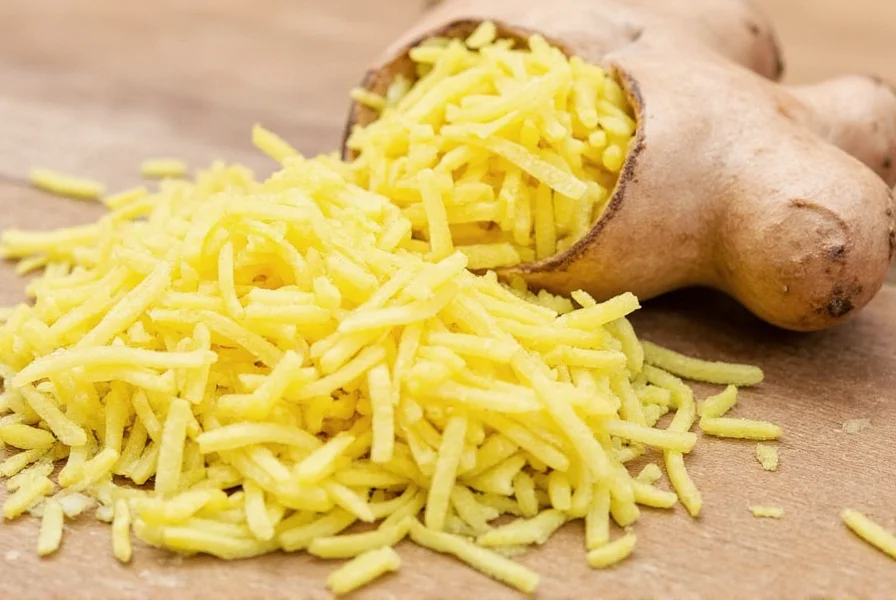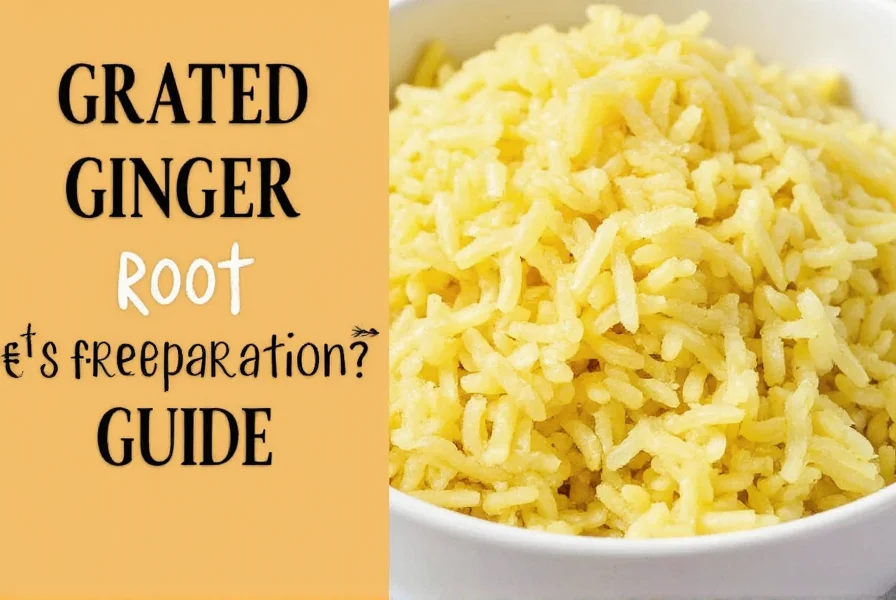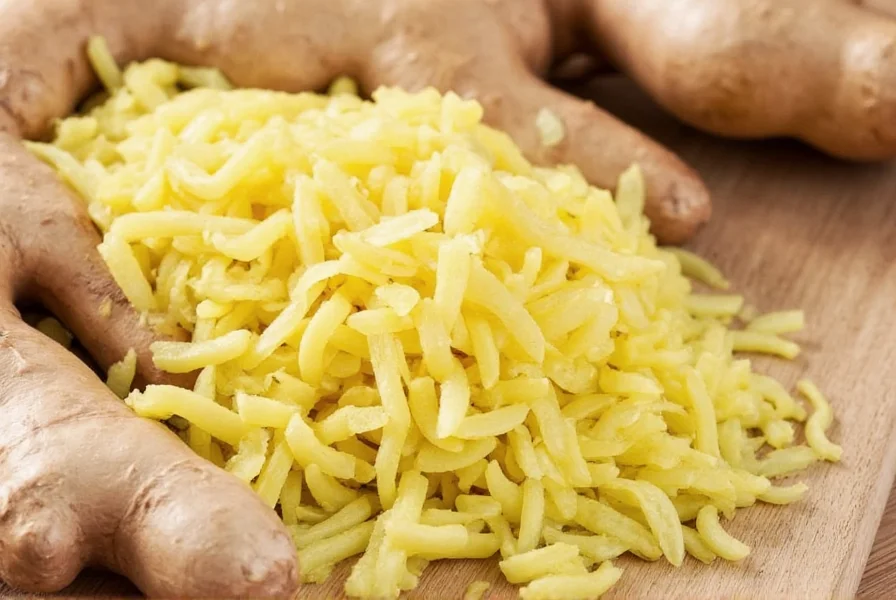When you prepare freshly grated ginger root, you unlock its full potential for flavor and nutrition. Unlike powdered alternatives, grated ginger maintains higher concentrations of bioactive compounds that provide both culinary depth and health-promoting properties. This versatile ingredient has been used for centuries in Asian cuisine and traditional medicine systems for its distinctive zesty flavor and therapeutic benefits.
What Exactly Is Grated Ginger Root?
Grated ginger root comes from the Zingiber officinale plant's underground rhizome. The grating process involves shredding the peeled or unpeeled root into fine particles using various tools:
| Grating Tool | Texture Result | Best For |
|---|---|---|
| Microplane | Finely shredded, almost paste-like | Marinades, dressings, delicate sauces |
| Box grater (fine side) | Thin shreds | Stir-fries, soups, baked goods |
| Japanese ginger grater (oroshigane) | Ultra-fine pulp with juice | Sushi accompaniments, clear broths |
The key difference between grated ginger and other forms lies in its moisture content and enzyme activity. Freshly grated ginger contains approximately 69% water, compared to ground ginger's 7-10% moisture, which affects both flavor release and shelf life. When you grate ginger root properly, you break cell walls that release zingiberene and other volatile compounds responsible for ginger's characteristic aroma.
Nutritional Profile and Health Benefits
Research published in the Journal of Agricultural and Food Chemistry confirms that freshly grated ginger root contains significantly higher levels of active compounds than processed forms. A single tablespoon (6g) of freshly grated ginger provides:
- 1.4 mg of gingerol (primary bioactive compound)
- 0.3 mg of shogaol (formed when ginger is heated)
- Trace amounts of zingerone
- 0.8 mg of vitamin C (1% DV)
- 0.6 mg of magnesium (1% DV)
The health benefits of fresh grated ginger stem primarily from these compounds. Clinical studies show that consuming 1-3 grams of freshly grated ginger daily can:
- Reduce nausea and vomiting, particularly during pregnancy or chemotherapy
- Decrease muscle pain and soreness after exercise by up to 25%
- Lower inflammation markers like CRP by 15-20% in osteoarthritis patients
- Improve digestion by accelerating gastric emptying by 21%

Culinary Applications of Grated Ginger
Professional chefs prefer using grated ginger in cooking rather than powdered forms because it delivers brighter, more complex flavor. The enzymatic activity in fresh ginger also affects other ingredients:
- In marinades: Ginger's protease enzymes tenderize meats without making them mushy
- In baking: Provides moist texture while activating leavening agents
- In beverages: Releases volatile compounds that create aromatic steam
- In sauces: Emulsifies fats while adding pungent heat
For Asian cuisine specifically, grated ginger forms the flavor foundation in many dishes. In Japanese cooking, it's essential for gari (pickled ginger) and shoga-yu (ginger tea). Chinese recipes often use it in dumpling fillings and stir-fry sauces, while Indian cuisine incorporates it into curry pastes and chai blends.
Proper Technique for Grating Ginger Root
Learning how to grate ginger root properly ensures maximum flavor extraction and safety. Follow these steps:
- Select firm ginger with smooth skin and no soft spots
- Peel using the edge of a spoon (preserves more flesh than a peeler)
- Freeze for 15 minutes to firm up the texture
- Grate against the tool's surface using downward motions
- Rotate the ginger to expose fresh surfaces
- Stop before reaching fibrous core sections
For best results, grate ginger immediately before use. Exposure to air causes enzymatic browning within 30 minutes, reducing both visual appeal and flavor intensity. If you need to prepare it ahead of time, mix with a small amount of lemon juice or vinegar to preserve color.
Storage Methods for Grated Ginger Root
Understanding proper storage methods for grated ginger root extends its shelf life while preserving potency. Unlike whole ginger, grated ginger has significantly reduced longevity due to increased surface area:
- Refrigeration: Store in airtight container with paper towel for up to 5 days
- Freezing: Portion into ice cube trays with water or oil for 3-6 months
- Vacuum sealing: Extends refrigerated life to 2 weeks when oxygen is removed
- Oil preservation: Submerge in neutral oil for up to 1 month in refrigerator
Research from the University of California shows that frozen grated ginger retains 92% of its gingerol content after 3 months, making freezing the optimal preservation method for maintaining health benefits of fresh grated ginger.
Grated Ginger vs. Other Forms
Understanding the differences between preparation methods helps you choose the right form for your needs:
- Grated vs. ground ginger: Grated contains 10x more gingerol and has brighter flavor
- Grated vs. pickled ginger: Fresh provides enzymatic benefits while pickled offers probiotic advantages
- Grated vs. candied ginger: Raw form has anti-inflammatory properties while candied serves as digestive aid
For therapeutic applications, freshly grated ginger outperforms other forms due to higher concentrations of active compounds. However, ground ginger works better in dry spice blends, while pickled ginger serves as a palate cleanser.
Recipes Featuring Freshly Grated Ginger
Incorporate recipes with freshly grated ginger into your routine for maximum flavor and health benefits:
- Ginger-Turmeric Immunity Shot: 1 tbsp grated ginger, 1 tsp grated turmeric, lemon juice, honey
- Asian Stir-Fry Sauce: 2 tbsp grated ginger, 3 tbsp soy sauce, 1 tbsp rice vinegar, 1 tsp sesame oil
- Ginger-Lemon Tea: 1 tbsp grated ginger simmered in 8 oz water for 10 minutes
- Marinade for Fish: 1 tbsp grated ginger, 2 minced garlic cloves, 2 tbsp olive oil, citrus zest

Substitutions When Grated Ginger Isn't Available
If you need grated ginger root substitutes, consider these conversion ratios:
- 1 inch fresh ginger = 1 tbsp grated ginger = ¼ tsp ground ginger
- For liquid recipes: 1 tbsp grated ginger = 2 tsp ginger juice
- For baking: 1 tbsp grated ginger = 1½ tsp crystallized ginger, finely chopped
Remember that substitutions won't provide identical results. Ground ginger lacks the bright top notes of fresh, while preserved forms offer different flavor profiles. When possible, seek out fresh ginger for authentic results in using grated ginger in cooking.
Frequently Asked Questions
What's the difference between grated ginger and ground ginger?
Grated ginger comes from fresh rhizomes and contains significantly higher levels of active compounds like gingerol (16 mg per gram versus 1.5 mg in ground ginger). It provides brighter, more complex flavor with citrusy top notes, while ground ginger offers a more muted, earthy flavor profile. Grated ginger also contains moisture that affects recipe chemistry, making it unsuitable as a direct 1:1 substitute for ground ginger in baking.
How much grated ginger equals ground ginger in recipes?
The conversion ratio is approximately 1 tablespoon of freshly grated ginger to ¼ teaspoon of ground ginger. This accounts for both the moisture content difference and the higher concentration of active compounds in fresh ginger. For recipes requiring intense ginger flavor, use a 3:1 ratio (3 parts grated to 1 part ground) to compensate for flavor degradation during drying.
Can I freeze grated ginger root for later use?
Yes, freezing is the best preservation method for grated ginger. Portion it into ice cube trays, cover with water or neutral oil, and freeze. Transfer frozen portions to airtight containers for storage up to 6 months. Frozen grated ginger retains 92% of its gingerol content and can be added directly to hot dishes without thawing. Avoid refreezing once thawed, as this significantly reduces potency.
Why does grated ginger sometimes turn blue or green?
This color change occurs in certain ginger varieties (particularly Hawaiian blue-ring ginger) when the gingerol compounds react with enzymes after grating. The blue-green pigment forms when gingerol converts to gingerone under specific pH conditions. This is completely natural and safe to consume, though it may indicate slightly reduced potency. The color change happens more frequently when using carbon steel graters compared to stainless steel.
How do I prevent grated ginger from burning in stir-fries?
To prevent burning, add grated ginger after aromatics like garlic and shallots, as it has a lower smoke point. Use medium-high heat rather than high heat, and immediately follow with liquid ingredients like soy sauce or broth to create steam that cooks the ginger without scorching. Alternatively, mix the grated ginger with 1 teaspoon of cold water before adding to the pan, which creates a protective barrier against direct heat.











 浙公网安备
33010002000092号
浙公网安备
33010002000092号 浙B2-20120091-4
浙B2-20120091-4